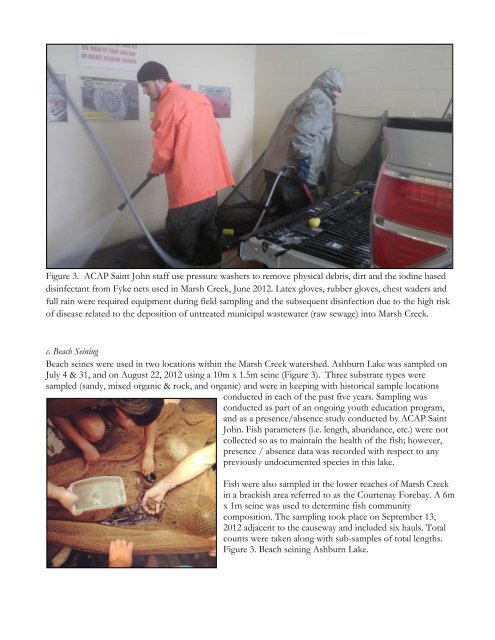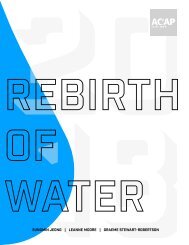Bio-Diversification in the Courtenay Bay Tidal Marsh
“The objectives of this study were to expand our understanding of the environmental attributes of Courtenay Bay, the tidal marsh and estuary of the Marsh Creek watershed. Field studies were conducted to ascertain the occurrence of diadromous fishes and migratory birds within the watershed...”
“The objectives of this study were to expand our understanding of the environmental attributes of Courtenay Bay, the tidal marsh and estuary of the Marsh Creek watershed. Field studies were conducted to ascertain the occurrence of diadromous fishes and migratory birds within the watershed...”
You also want an ePaper? Increase the reach of your titles
YUMPU automatically turns print PDFs into web optimized ePapers that Google loves.
Figure 3. ACAP Sa<strong>in</strong>t John staff use pressure washers to remove physical debris, dirt and <strong>the</strong> iod<strong>in</strong>e based<br />
dis<strong>in</strong>fectant from Fyke nets used <strong>in</strong> <strong>Marsh</strong> Creek, June 2012. Latex gloves, rubber gloves, chest waders and<br />
full ra<strong>in</strong> were required equipment dur<strong>in</strong>g field sampl<strong>in</strong>g and <strong>the</strong> subsequent dis<strong>in</strong>fection due to <strong>the</strong> high risk<br />
of disease related to <strong>the</strong> deposition of untreated municipal wastewater (raw sewage) <strong>in</strong>to <strong>Marsh</strong> Creek.<br />
c. Beach Se<strong>in</strong><strong>in</strong>g<br />
Beach se<strong>in</strong>es were used <strong>in</strong> two locations with<strong>in</strong> <strong>the</strong> <strong>Marsh</strong> Creek watershed. Ashburn Lake was sampled on<br />
July 4 & 31, and on August 22, 2012 us<strong>in</strong>g a 10m x 1.5m se<strong>in</strong>e (Figure 3). Three substrate types were<br />
sampled (sandy, mixed organic & rock, and organic) and were <strong>in</strong> keep<strong>in</strong>g with historical sample locations<br />
conducted <strong>in</strong> each of <strong>the</strong> past five years. Sampl<strong>in</strong>g was<br />
conducted as part of an ongo<strong>in</strong>g youth education program,<br />
and as a presence/absence study conducted by ACAP Sa<strong>in</strong>t<br />
John. Fish parameters (i.e. length, abundance, etc.) were not<br />
collected so as to ma<strong>in</strong>ta<strong>in</strong> <strong>the</strong> health of <strong>the</strong> fish; however,<br />
presence / absence data was recorded with respect to any<br />
previously undocumented species <strong>in</strong> this lake.<br />
Fish were also sampled <strong>in</strong> <strong>the</strong> lower reaches of <strong>Marsh</strong> Creek<br />
<strong>in</strong> a brackish area referred to as <strong>the</strong> <strong>Courtenay</strong> Forebay. A 6m<br />
x 1m se<strong>in</strong>e was used to determ<strong>in</strong>e fish community<br />
composition. The sampl<strong>in</strong>g took place on September 13,<br />
2012 adjacent to <strong>the</strong> causeway and <strong>in</strong>cluded six hauls. Total<br />
counts were taken along with sub-samples of total lengths.<br />
Figure 3. Beach se<strong>in</strong><strong>in</strong>g Ashburn Lake.


















